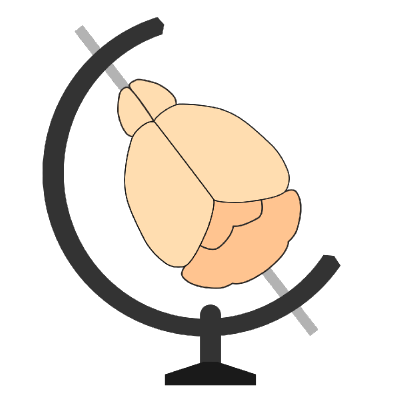About#
Introduction#
The BrainGlobe Initiative (BGI) was originally established by researchers at the Sainsbury Wellcome Centre and the Technical University of Munich.
We collaborate with researchers from the EBRAINS Norwegian node based at the University of Oslo, to establish and implement standards and tools for atlases and their metadata.
The core goal of BrainGlobe is to develop a suite of Python-based software tools for computational neuroanatomy. We have developed several software packages to access, analyze and visualize anatomical data. By ensuring the interoperability of all of BrainGlobe’s software, we aim to streamline the development of analysis pipelines and facilitate the process of going from raw data to publication-ready content. By producing a set of high-quality open-source Python packages, we aim to accelerate the development of sophisticated analysis tools in python.
Accessing data#
Recent developments in high-resolution 3D electronic atlases for many model species and in high-throughput experimental techniques have enabled the production of a wealth of anatomical data and the creation of vast neuroanatomical datasets. However, accessing, downloading and using these data remains a challenging task which requires significant programming skills.
We aim to facilitate the access to available datasets, and have developed several tools to support this. For example, we developed morphapi which can be used to download neuronal morphological data, and brainrender which provides functionality to download gene expression and mesoscale connectomics data for the mouse brain from the Allen institute.
A core step towards facilitating the usage of atlas data was also taken by developing the BrainGlobe AtlasAPI. This tool provides a simple and unified interface for downloading and using data from a number of available atlases. Additionally, new atlases can easily be added to the API. With this tool we address a major obstacle when developing software for neuroanatomy: few of the available atlases provide programmatic access to their data, and the APIs used to access the data vary across atlases. This obstacle resulted in most of the available software being dedicated to individual atlases or even datasets, requiring that additional and often duplicated effort be spent in adapting existing software to new atlases. By providing a unified API, we aim to facilitate the development of software capable of working across atlases. The AtlasAPI is used by other BrainGlobe software tools like cellfinder and brainrender, ensuring that they can effortlessly work in different model species.
Analyzing data#
The registration of anatomical data to a reference image (from an atlas) is a crucial step in the analysis of anatomical data. Registering the data enables the comparison of data across individuals and experimental modalities and facilitates the dissemination of anatomical data. It is also indispensable to easily compare user-generated data with data from publicly available datasets.
Registering 3D image data to a reference atlas is a technically demanding task. For this reason, we developed brainreg, a Python-based software tool for the 3D registration of anatomical data
cellfinder uses a deep learning algorithm to identify the location of labelled cells (e.g. expressing a fluorescent protein) across an entire brain. It thus provides a fast, reliable and reproducible approach to the quantification of data from many experiments (e.g. viral tracing).
Visualizing data#
In addition to downloading and analyzing data, visualization is a core step in any analysis pipeline. The creation of images and videos from data is crucial for both inspecting the results of analysis steps and for communicating one’s findings. We developed brainrender to facilitate the creation of high-quality 3D interactive renderings of anatomical data. The necessity to visually explore increasingly large and rich datasets in 3D is clear in neuroanatomy: given the complicated 3D structures of many types of data (e.g. neuronal morphologies), 2D alternatives are a poor substitute for 3D renderings. However, the creation of high-quality renderings remained a challenging technical problem. With brainrender, we provide a user-friendly interface and a powerful and flexible rendering tool to ensure that any scientist can create rich and beautiful renderings of their anatomical data.
Future#
In addition to developing our own software, we are working to build a community of neuroscientists and developers to leverage the vast data analysis ecosystem in Python for the analysis of neuroanatomical data. To catalyse this, we aim to “fill the gaps” where tools do not exist, and develop frameworks to facilitate collaboration. Our key future aims are:
To enable the use of BGI tools across neuroscience by supporting all available high-quality neuroanatomical atlases
To reduce barriers of entry and make sure BGI tools are accessible to all
To ensure BGI tools and atlases can be incorporated into varied workflows to leverage the open-source image analysis community
